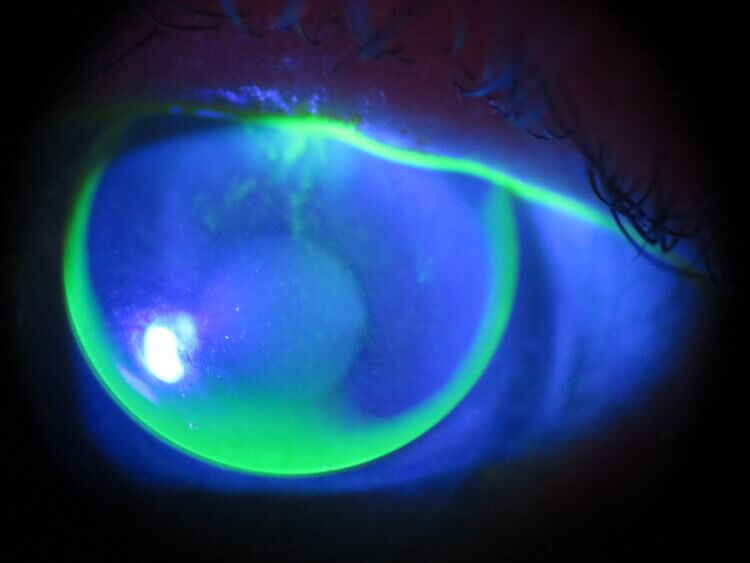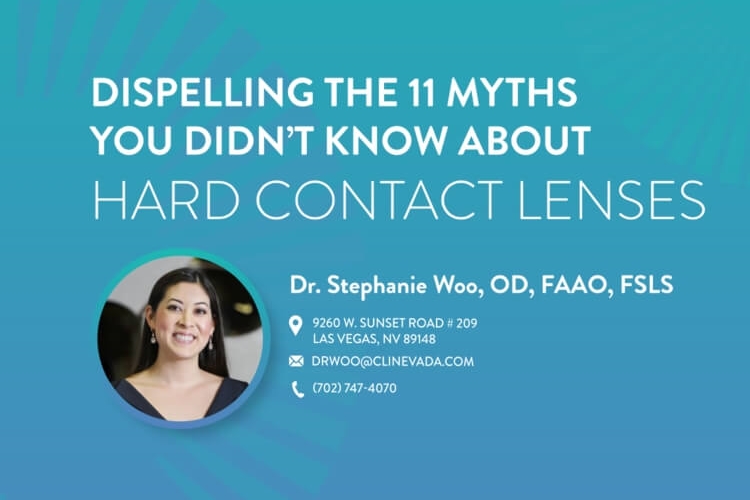What are GP lenses?
Did you know there are different types of contact lenses besides the widely known soft contacts? Gas permeable lenses are another fabulous lens option that is made of a rigid durable silicone. Its rigid structure producessharp crisp vision because of its ability to retain its shape. This makes it a good option for patients with astigmatism or those who desire sharper vision.GP lenses are able to correct astigmatism to a greater extent than soft contacts. The material that forms these lenses allows for oxygen to pass through to your cornea (front of your eye), ensuring optimal environmental conditions for your eye in order to maintain its health. They are more hygienic as they clean and disinfect easily. They don’t hold onto deposits like soft contact lenses do because they aren’t made of water! They tend to be cost effective due to its infrequent replacement schedule. Gas permeable lenses are a great option for vision correction due to its many benefits. These include the ability to provide crisp vision and its reduced risk of health problems. Speak to your eye doctor to determine if these lenses are a right fit for you!


What are the advantages?
- Oxygen flow
- The GP lens design and the material used allows for your eyes to “breathe” by facilitating more oxygen flow. In comparison to soft contact lenses, gas permeable lenses place you at lower risk for eye problems that are associated with reduced oxygen supplies (hypoxia). The lenses are smaller in diameter and therefore cover less of the surface of the eye, allowing for more natural oxygen exchange. The rigid form of the lens prevents flexure of the lens while blinking, providing ample room for tears to flow beneath the lens and circulate your oxygen containing tears.
- Less dry eye
- GP lenses do not require the hydration needed in soft contact lenses. Therefore, they do not dry out and irritate your eyes as well. This also helps to preserve the clarity of vision.
- Better vision
- GP lenses contain customized parameters in order to better fit your eye. This provides sharper vision than possible with soft contact lenses. Soft contact lenses may dry out over the course of the day and cause fluctuations in vision. The use of gas permeable lenses avoids these issues. Astigmatism correction is targeted more accurately, contributing to a sharp image.
- Better durability
- They last longer! The rigid material prevents rips or tears from forming with handling.
- Deposit resistance
- The material that composes GP lenses does not contain water like soft contacts do. Therefore, proteins and lipids do not easily adhere to the surface of the lens.
- Less expensive long term
- GP lenses are commonly replaced on an annual basis. In addition, their rigid structure that prevents rips or tears eliminates the need to buy replacements. Since the lenses are easier to clean and care for, they also result in a reduced need to replace and even less infection. This decreased risk of infection means less visits to the eye doctor per year!
- Prevents progression of near sightedness
- Research has shown an association between gas permeable wear and the progression of myopia (near sightedness) in children. If your child or someone you know has shown a progressive increase in their nearsightedness, talk to your eye doctor about using gas permeable lenses as preventative treatment.
- Ortho-K use
- GP lenses are used in orthokeratology. This is a specially designed contact lens that is worn during sleep and taken off during the day. It allows for good vision during the day without glasses. Most patients achieve 20/20 visual outcomes.
What are the downsides?
Adaptation poses the most daunting challenge of gas permeable lenses. In contrast to soft contact lenses, GP lenses require an adaptation period in order to become accustomed to the feel of the lens material. The size of the lens is smaller than that of a soft contact. Therefore, a new wearer may be overly aware of the lens edge as they blink. Over time this feeling goes away as adaptation occurs. Part time wear with GP lenses is difficult because full adaptation and sustained comfort comes with wearing them every day. In addition, the smaller size of the lenses makes them more susceptible to dislodging during the eye during sports or other activities. The rigid lens form allows for tears to circulate better under the lens. However, this means that it is more likely that sand and dust go under the lenses. Another consideration would be higher replacement costs and slower turnaround time. GP lenses are custom made for your eye in order to provide the best vision and fit. Therefore, a new order of lenses takes time and is typically more costly than soft lenses. Purchase of a backup pair with the original order would minimize this issue.

Who is a good candidate for GP lenses?
Some examples of patients who would be a good fit for GP lenses are as follows:
- Patients who are willing to go through an adaptation period
- Patients willing to adhere to the cleaning regime required
- Failed soft contact lens wearer
- Patients prone to soft contact lens complications
- Patients desiring sharper vision
- Astigmatism that is not adequately corrected with the use of soft contacts
- Patients over 40 who require a reading prescription and a distance prescription at the same time
- Lens options are available that incorporate both a near and a distance prescription all in one lens. This is ideal for patients who want to avoid carrying around reading glasses!
- Keratoconus patients
- The rigid lens structure assists in correction of corneal conditions like keratoconus. GP lenses provides adequate vision in cases that are not possible with soft contacts or glasses.
- Those who require contact lenses following surgery
- Those interested in or qualify for orthokeratology
- Those who do not want to replace their contact lenses often
Gas Permeable Lens Care Instructions
There are many different options for keeping your GP lenses clean and cared for. Below we go over a few examples of cleaning systems and how to use them. The difference between two bottle and one bottle systems is in the name itself—one requires the use of two separate bottles while the other system is an all-in-one. Oxidative systems are good for patients with allergies to preservatives or are prone to chemical toxicity.
Two bottle system instruction: remove your lenses at night and rub them clean with the red cap cleaner system. Rinse this thoroughly with saline. Soak the lenses in the blue capped conditioner overnight. You may insert the lenses in the morning.
- Two bottle system examples
- Boston Original
- Boston Advance
One bottle system instruction: remove lenses at night and rinse with white capped solution. Soak in the same solution overnight. In the morning, you may insert the lenses.
- One bottle system examples
- Boston Simplus
- Unique pH
Oxidative system instruction: remove lenses at night. Rub the lenses and rinse with the red capped solution. Soak in the same red capped solution over night for a minimum number of hours (indicated on the bottle). In the morning, you may rinse the lenses with saline before inserting if you prefer or just simply insert.
- Oxidative system examples
- Clear Care
- Clear Care Plus
Frequently asked questions about GP lenses
How often do I have to replace my lenses?
GP lenses are replaced once per year. This is ideal for patients who do not want to worry about multiple pairs of contacts or frequent replacement.
Can GP lenses correct my astigmatism?
Yes! The rigid structure of the lens as well as the personalized fabrication of each GP lens provides the best vision possible. It can correct astigmatism more accurately than a typical soft contact lens.
I lost my GP lenses, how do I replace them?
Contact your eye doctor for assistance with placing a new order. Since the lenses were custom made for your eye, your eye doctor will have the information necessary to order a replacement and have you seeing your best as soon as possible.
Is there any lens that could give me the sharp vision of GPs with the comfort of soft lenses?
Yes, hybrid lenses are available to address these problems. If a GP lens and s soft contact lens had a baby, it would be a hybrid lens! The center portion that provides you vision correction is composed of a gas permeable lens. This center portion is surrounded by a skirt that is made of a soft contact lens. Ask your eye doctor if you are a candidate for this lens!
How do you know the lens is fitting well on my eye?
Your eye doctor will incorporate the use of a colored dye and a blue light to assess how the lens is fitting on your eye. Additional technology is used in assisting the doctor determine the best fit such as a corneal topographer—a machine that maps out the front surface of your eye.
If the lenses are rigid, will it damage my eye?
On the contrary, gas permeable lenses tend to be healthier for the eye due to its increased oxygen flow and tear circulation. However, this does not mean they are completely risk free. Placing any type of contact lens in your eye puts you at risk for infection or complications. GP lenses have proven to be associated with less of these complications than soft contact lenses.

